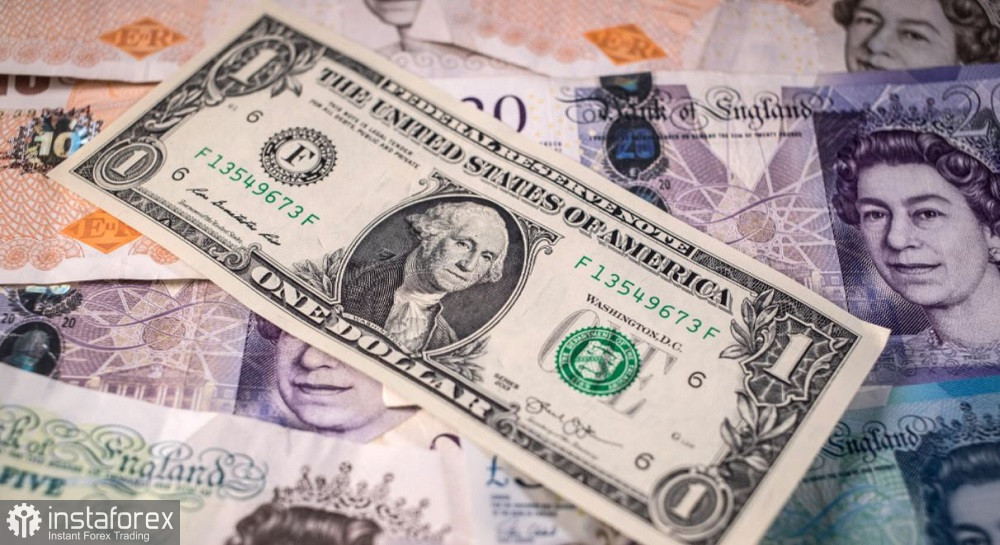The GBP/USD pair has been rising for the second consecutive day. The pound overcame the resistance level of 1.2700 (the middle line of the Bollinger Bands indicator on the daily chart) and is now trying to approach the 1.2800 level. On Monday, the bulls already tested this price barrier but failed, causing the pair to retreat to the base of the 1.2600 level. Now the pair is making a second attempt, and as we can see, with more success this time. However, this is entirely due to the dollar's broad weakness across the market – the pound is merely taking advantage of the situation.

The dollar index is plummeting, reacting impulsively to the release of the ISM Services Purchasing Managers' Index, weekly U.S. labor market data, and the ADP report. All releases came out in the "red", signaling a potential cooling of the U.S. labor market. These are very alarming signs ahead of Friday's Nonfarm Payrolls. Meanwhile, the JOLTs figures were in the "green," indicating an opposite trend. But traders focused on the negative (for the dollar) fundamental factors, which is why the GBP/USD pair is actively rising, hitting 3-week highs. Such one-sidedness could backfire on the pair's buyers and the dollar's opponents. If June's Nonfarm Payrolls surprisingly come out in the "green," we might witness a dollar rally amidst low expectations about the U.S. labor market dynamics.
But let's focus on the latest reports. Weekly data on initial jobless claims were published. Since mid-May, this indicator has shown an upward trend, reaching its (multi-month) peak of 243,000 in early June. Since then, the figure has neither risen nor fallen below the 230,000 target. This report was no exception: last week, the number of jobless claims increased to 238,000 (against a forecast of 234,000).
Another U.S. labor market report also came out in the "red". The Automatic Data Processing (ADP) company published a report indicating that employment in the U.S. private sector grew by 150,000 in June. Most experts expected 163,000. An ADP representative said that employment growth last month was quite steady, but it lacked a broad base. The representative also suggested that if it weren't for the growth in leisure and hospitality employment, June would have been a very unfavorable month.
It is important to note that last month's ADP report also came out in the "red" (157,000 against a forecast of 168,000). However, the official increase in nonfarm payroll employment was nearly 100,000 higher (272,000). Therefore, no definitive conclusions should be drawn from the latest reports. Moreover, the market's lowered expectations could amplify the positive effect for the greenback if the Nonfarm Payrolls turn out better than forecasted (especially if the wage figure remains at least at May's level).
It is also worth noting that, according to data on Tuesday, the number of job openings in the U.S. (JOLTS) in May exceeded 8 million (8.14 million), against a forecast of 7.9 million. The indicator had been declining for the last two months but resumed growth in June.
A sharp slowdown in the growth rate of job openings would indicate that the labor market has become more balanced and the pressure on wage growth has decreased. But the JOLTS data turned out to be quite strong.
In other words, the intrigue surrounding the June Nonfarm Payrolls remains, but the market is currently focused on other fundamental factors. The declining ISM Manufacturing index, the "red" ADP report, and the rise in initial jobless claims—all these factors are putting pressure on the greenback.
The ISM Services PMI also mounted pressure on the dollar. In May, this indicator left the contraction zone, reaching 53.8 points. According to forecasts, the index was expected to edge lower in June (to 52.6) but remain in the expansion area. Instead, the indicator plummeted to 48.8. This is a 4-year low—the lowest level since June 2020. After this report, dollar bulls were knocked down, and the GBP/USD pair jumped to 1.2775.
In my opinion, in the coming days, the pound will follow the greenback, which will be under substantial pressure due to the latest macro data. Strong Nonfarm Payrolls could serve as a lifeline for the dollar, but until then, the greenback is unlikely to be in high demand.
The nearest target for the upward movement is the 1.2800 mark (the upper line of the Bollinger Bands on the daily chart). The next target is 1.2860 (the upper line of the Bollinger Bands on the daily chart).
 English
English 
 Русский
Русский Bahasa Indonesia
Bahasa Indonesia Bahasa Malay
Bahasa Malay ไทย
ไทย Español
Español Deutsch
Deutsch Български
Български Français
Français Tiếng Việt
Tiếng Việt 中文
中文 বাংলা
বাংলা हिन्दी
हिन्दी Čeština
Čeština Українська
Українська Română
Română

